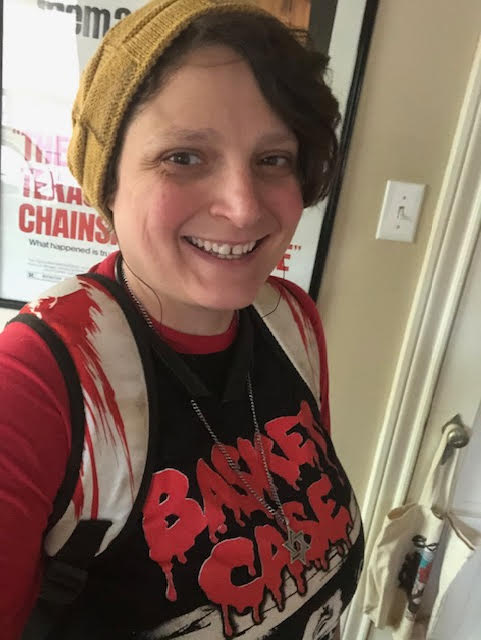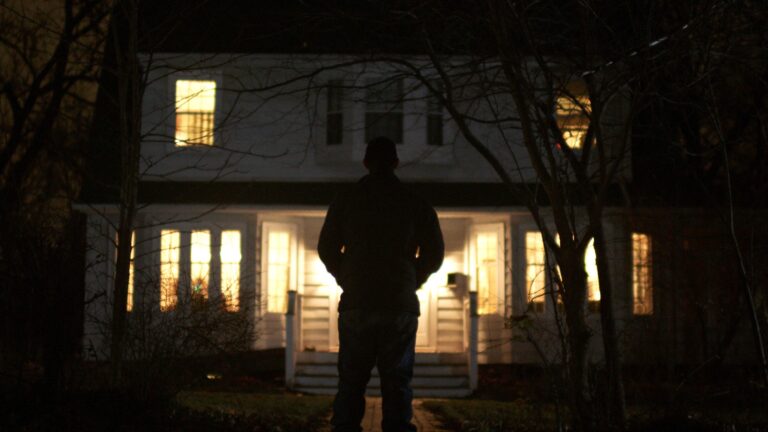A break-in does not just equate to the loss or destruction of property. When someone enters your home, the damage is much more than the monetary value of stolen items. There’s also a loss of security and peace of mind. The safe place you have so delicately curated and meticulously made your own has become violated and defiled. The lingering fear doesn’t just come from what was taken but from the knowledge that someone was there, that your personal space was infiltrated, and that the walls that once protected you have failed. This feeling of intrusion and helplessness is at the core of Mickey Keating’s Invader. A 70-minute adventure into sheer, unrelenting dread. Opening in select theaters on February 21, Invader thrives not on conventional scares but on the creeping, suffocating anxiety that something is very, very wrong.
“A break-in occurs every 30 seconds in the U.S.”
Vero Maynez stars as Ana, a young woman who arrives in a desolate Chicago suburb to visit her cousin, Camila (Ruby Vallejo). From the moment Ana arrives in the city, something feels wrong. Camila doesn’t answer the door, and her phone goes straight to voicemail. At first, Ana is annoyed as she walks eight kilometers through town, only to have no one answer the door. But as she searches for answers, it becomes clear that her cousin’s disappearance is far more than a simple case of missed calls. With the help of Camila’s co-worker, Carlo (Colin Huerta), Ana starts uncovering unsettling clues about her cousin’s disappearance and soon finds something very disturbing in the family home.
Director Mickey Keating
Keating is no stranger to crafting atmospheric horror (Darling, Offseason), but Invader might be his most immersive film yet. The way he shoots this movie is designed to make you feel as trapped and disoriented as Ana herself. Nearly every shot is a tight frame with a claustrophobic close-up. This makes you hyperaware of every twitch, every bead of sweat, and every nervous glance. And when Keating pulls back the camera, it’s to a vast, overwhelming wide shot that makes Ana look minuscule in the empty, decaying streets. This sense of visual imbalance keeps the audience on edge and makes us wonder what is waiting for us around the corner.
For all its intensity, Invader is surprisingly light on exposition. There’s barely any dialogue; when characters speak, it’s often in hushed tones. The story unfolds through unsettling imagery and implications rather than explicit explanations. This lack of hand-holding makes the horror feel more organic and more real. It’s the kind of movie that trusts its audience to pick up on the details rather than spoon-feeding them every answer. Some might find this frustrating, but for those who love their horror ambiguous and unsettling, Invader is a dream (well, more like a nightmare) come true.
The Missing
Beyond its relentless atmosphere, Invader carries a quiet but profoundly unsettling layer of social commentary. While obviously, the film’s primary horror stems from the terror of home invasion, much of its dread comes from a far more insidious reality. The widespread disappearance of Brown women highlights the systemic indifference that allows these cases to remain unresolved. Every year, thousands of Black and Brown women go missing in the United States. Yet, their cases receive disproportionately little media coverage or law enforcement urgency. This reinforces the idea that their lives are seen as less valuable.
Keating sets this horror against the backdrop of a decayed and eerily empty suburban neighborhood. Once part of the so-called American Dream, it’s now a ghost town where those left behind are ignored or forgotten. Ana’s growing desperation to find Camila is met with apathy. It mirrors a real-world crisis where the families of missing women of color must fight just to be heard. Keating never makes these themes overt; they linger beneath the surface. They are mixed into the film’s oppressive tone, which makes Invader a harrowing horror film and a grim reflection of a reality too often ignored.
The Invader
And let’s talk about the villain! Without giving too much away, Invader takes a brilliantly stripped-down approach to its antagonist. There’s no tragic backstory, no psychological justification, and no elaborate reasoning; instead, we get just a raw, unfiltered menace. This absence of context makes the horror feel disturbingly accurate, as if it could happen to anyone, anywhere, without warning. The bad guy is a chilling throwback to classics like Leatherface or Michael Myers. He is an evil who simply exists and needs no explanation. That relentless and oppressive atmosphere is what makes Invader so effective. However, some might argue that it leans almost too hard into its intensity. Even at a brisk 70 minutes, the final stretch lingers slightly longer than necessary. While the ending is undeniably thrilling, a tighter conclusion might have strengthened it. But these are minor nitpicks in an otherwise brutal horror film.
Ultimately, Invader forgoes cheap jump scares and elaborate character designs in favor of pure atmosphere, relentless tension, and a creeping sense of dread that refuses to let go. Casual horror fans might find it too overwhelming. But for those who crave their horror raw, unfiltered, and deeply unsettling, Invader is the kind of horror that follows you home. If you’re ready to have your nerves frayed and your sanity tested, mark your calendar for February 21st, but maybe bring some Xanax because you’re going to need it.






